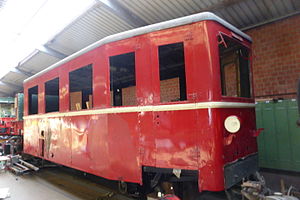MEG T 1 to T 8
| MEG T 1 to T 8 | |
|---|---|
|
T 7 at the IHS in Schierwaldenrath in processing (2015)
|
|
| Numbering: | MEG T 1-8 IHS T 7 |
| Number: | 8th |
| Manufacturer: |
Waggonfabrik Gotha Orenstein & Koppel |
| Year of construction (s): | 1934-1941 |
| Retirement: | until 1972 |
| Axis formula : | A1 dm |
| Gauge : | 1000 mm ( meter gauge ) |
| Length over coupling: | 9002 mm |
| Length: | 8,200 mm |
| Height: | 3,300 mm |
| Width: | 2,600 mm |
| Total wheelbase: | T1-T3: 4,000 mm T4-T8: 4,500 mm |
| Empty mass: | 7,900 kg |
| Service mass: | 8,100 kg |
| Top speed: | 55 km / h |
| Installed capacity: | 51 kW (70 hp) |
| Motor type: | Daimler-Benz OM 65 |
| Motor type: | Four-cylinder four-stroke diesel engine |
| Rated speed: | 2,000 rpm |
| Power transmission: | mechanical with Mylius gear |
| Train heating: | Originally hot water last furnace heating |
| Seats: | 33 |
| Standing room: | 27 |
The T 1 to T 8 combustion railcars of the Mittelbadische Eisenbahn-Gesellschaft (MEG) are diesel-mechanical railcars with an A1 wheel arrangement. The T 7 is now owned by the Historical Rail Transport Association. V. (IHS).
history
The need to rationalize and save operating costs led to the development of combustion railcars by various manufacturers in the 1930s. The Wismar wagon factory was particularly successful .
The Waggonfabrik Gotha , which since 1931 has been majority owned by Orenstein & Koppel , delivered a total of eight two-axle diesel railcars to MEG from 1934 to 1941, making it the largest standardized railcar series for a German narrow-gauge railway. If necessary, they could take a sidecar with them and thus take over most of the passenger traffic on the 115 km long MEG network between Rastatt and Lahr .
The vehicles performed well, especially when driving through town on the MEG. In the course of time it became clear that the railcars could no longer cope with the increasing traffic, which led to the procurement of the MEG T11 as well as MEG T12 and T13 with greater engine power.
Due to a lack of fuel, some railcars were equipped with Imbert type wood gasification systems during the Second World War , which were removed after the end of the war. On the preserved T 7 , the buffer beam extended at one end of the car is part of the renovation at that time. Originally dark blue and ivory, the railcars were painted red from the early 1960s.
In October 1953 the MEG workshop in Schwarzach burned down with the T 8 in it . The railcar was then rebuilt.
Due to the growing road traffic, the trains in the towns became more and more of a traffic obstacle. With the shrinking of the MEG network, the decommissioning of the railcars began. The T 2 was the first to be retired in 1947 . From 1962, the wave of decommissioning began. As the last of its type, the T 7 , built in 1939 under the serial number 28585 , was in use until passenger traffic on the MEG was discontinued on September 26, 1970 and drove for two years as a service and general cargo railcar, in 1972 the IHS acquired it. It has been in the process of processing since 2015.
Constructive features
The vehicles corresponded to the principles of lightweight construction of the time. The car body, welded from profiles and sheet metal, had retracted ends. The form of construction offered the wagon factories the opportunity to produce variants of the vehicles on customer request. If necessary, the revolving doors, which were to be opened to the outside, could be enlarged in the clear width with an additional leaf.
The machine system, consisting of the Daimler-Benz OM 65 engine and the Mylius gearbox , was located below the floor and drove an axle of the railcar via cardan shafts. The equipment of the wagons also included furnace heating, electrical lighting, warning whistles and bells, indirect brakes and the pulling and bumpers used by MEG with a central buffer and the pulling hook below. They also had side draw hooks.
literature
- Günther Steinhauer among others: The vehicles of the Selfkantbahn . Ed .: Interest group for historical rail traffic e. V. 2nd completely revised edition. Schweers + Wall, Aachen 1980, ISBN 3-921679-14-1 , pp. 16-17; 44 .
- Klaus-Joachim Schrader: Motor coaches on small railroad tracks . Ed .: Wolfgang Zeunert. Wolfgang Zeunert, Gifhorn 1971, p. 6-7 .
- Gerd Wolff / Hans-Dieter Menges: German small and private railways, Volume 2: Baden . Ed .: Railway Courier. EK-Verlag, Freiburg 1992, ISBN 3-88255-653-6 , p. 186-221 .
Web links
- Page about the T 7
- Overview of the IHS vehicles
- Restoration of the T 7
- MEG T7 1970 on a workshop trip at the Joachim Schmidt Railway Foundation
- Gotha railcar in front of a MEG passenger train passing through town in Kehl at the Joachim Schmidt Railway Foundation
Individual evidence
- ^ Gerd Wolff / Hans-Dieter Menges: German small and private railways, Volume 2: Baden . Ed .: Railway Courier. EK-Verlag, Freiburg 1992, ISBN 3-88255-653-6 , p. 186-221 . Page 188
- ↑ a b Gerd Wolff / Hans-Dieter Menges: German small and private railways, Volume 2: Baden . Ed .: Railway Courier. EK-Verlag, Freiburg 1992, ISBN 3-88255-653-6 , p. 186-221 . Page 220
